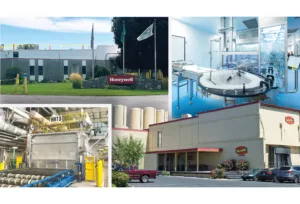West Plains growth dampened
Problems with storm runoff, ground water create big challenge;<br>county can require up to 40% of a site be dedicated to evaporation
Water problems that have plagued a host of West Plains construction projects, including most recently work on the BFGoodrich airplane brake plant, now may also be putting a wet blanket on commercial and industrial development efforts in an area long considered ripe for economic growth.
Across the board, those who have had to deal with the ground-water woes and storm-water runoff dilemmas therefrom developers, contractors, and engineers to government and economic-development officialssay the problems are significant and expensive. One goes so far as to say the West Plains is being held hostage to the water issue.
Still, they say, the problems are solvable, and efforts to find solutions are under way.
Id hate to see one area get a black eye over something we can solve, says Spokane County Engineer Bill Johns.
Still, some real estate agents who market land on the West Plains say the disadvantages already loom large in the minds of potential buyers.
Theres such a perception of concern that it has become difficult, says Pete Thompson, of Hawkins Edwards Inc., a Spokane real estate brokerage.
Thompson says many potential buyers are put off by the belief that building on the West Plains could be difficult or expensive because they might run into ground water or have to dedicate large portions of a site to drainage. Construction delays or the dedication of land to evaporative ponds drive up development costs, he says.
It costs more than they plan so they think, Why not spend more on the land and go somewhere else, like in the Valley or out at Liberty Lake? Thompson says.
He says the issue comes up in discussions with potential clients, but he cant point to any companies that have chosen not to locate on the West Plains solely because of water concerns. He still says, however, that the area is being held hostage to the water issue, and calls for progressive solutions.
Overall though, the Spokane areas reputation as a place to locate a business hasnt been harmed by the water problems, even though the problems have hit high-profile companies, contends Mark Turner, president of the Spokane Area Economic Development Council (EDC).
The problems are not so notorious that they come up in recruiting companies here, he says. The potential for a deterrent effect is there, though, so we see the need to seek solutions as part of our long-term strategy (to encourage economic growth).
Solutions already are being sought. Spokane County is starting work on a storm-water management plan for the West Plains and elsewhere, says Brenda Sims, the countys storm-water utilities manager. The county currently is in contract negotiations with a consultant who would study the geology of the West Plains and examine options for dealing with storm-water runoff there.
The county also is developing storm-water plans to handle drainage problems in 14 other planning areas around the county, Sims says. Preliminary figures estimate the cost to develop a countywide drainage system at about $62 million, and the county now is working on a financing strategy.
To bring public and private efforts together on the West Plains problems, Mike Taylor, president of Taylor Engineering Inc. and current chairman of the EDC, has organized several meetings at his office for city, county, and state officials, developers, engineers, and consultants who work with water issues on the West Plains. He says the informal group wants to pool its resources to take a closer look at potential strategies to deal with the water issues and to clarify rules governing possible solutions.
I think the general consensus is that there is work to be done, and this group can do it, Taylor says.
Challenges seen on the West Plains, from waterlogged soil to the need to dedicate large portions of building sites to handle storm-water runoff, stem from the underlying geology.
The West Plains area largely consists of shallow soil atop a bedrock of solid basalt, a volcanic rock left by lava flows. Water on the surface cant seep deep into the ground, Sims says.
Also, the West Plains slopes only gently, at about a 1 percent grade, to the north and northeast toward the Spokane River, Taylor says. It doesnt have that downhill drainage, he says.
Sims says that as a result of those geologic conditions, surface water on the West Plains collects in potholes and soggy lowlands and mostly is carried away only through evaporation.
Water that seeps into the ground flows into a water table that is very near the surface. After a 30-year low-rain period ended in 1993 and a wetter period predicted to last 15 years began, ground-water levels appear to be rising even closer to the surface than they were just a few years ago, Taylor says.
Handling storm water
The county doesnt have a public system of storm drains on the West Plains, Sims says, so runoff there must be handled with evaporative ponds constructed at each developed site. These ponds, lined with an impermeable layer of clay or plastic to prevent water from seeping down, collect water from rain or melting snow that runs off buildings and paved areas. The water is held in the ponds until it evaporates.
These ponds take up a large section of land for a private site, Sims says. She says as much as 40 percent of some sites must be dedicated to handling runoff.
It can be very difficult for a developer to solve the problem on his own site, Sims says. Some sort of shared public system may be necessary.
I would rather devise a better solution than evaporative lagoons, Taylor says. They take a lot of land and usually arent very attractive.
One option, he says, might be a spine and rib system that collects storm water from numerous sitesthe ribsand carries it away through a large ditch or pipethe spine. The spine could take the water to a common pond or wetland, or it could be piped through low ridges to the Spokane River.
Taylor says that at the meetings he has organized, some participants have advocated development of such a system through storm-water-utility benefit districts that could be formed by landowners, who would assess themselves to pay for the improvements. Others want the county to ensure the system is integrated from one drainage area to the next.
The county also is looking at ways to improve evaporative ponds, says Johns. For instance, adding sprinklers that would spray water from the ponds into the air above might speed up evaporation. Also, instead of depending solely on evaporation, ponds could include an outlet that would let some water drain away, perhaps to a shared system.
The ground-water issue
Still, evaporative ponds and runoff collection systems arent designed to handle ground water that might be encountered during excavation, Sims says. While the amount of storm water can be estimated from historical averages, when ground water comes into play, its much more troublesome to figure out how much water will be involved, she says.
Ground water also is a resource people count on and own rights to use, and that must be taken into account, Sims says. Its important to leave water in the areas where its needed when its drained out of areas where it causes problems. For example, pumping ground water from a building site where flooding is a problem may lower the water levels in wells on adjacent properties.
Taylor says plans for dealing with ground water can be complicated further because the state Department of Ecology has only one watermaster for 13 counties in Eastern Washington, so processing water-rights claims can take years.
During construction of BFGoodrichs big airplane-brake plant on Westbow Lane, which was designed with a below-grade floor, the company ran into both ground water and trouble with regulations regarding what it could do with it. The city of Spokane held water rights to use a certain amount of water from that drainage basin, and at one time had extracted water from a well near Spokane International Airport, then later abandoned the well. BFGoodrich and the city now are negotiating a transfer of one of the citys water rights so the company can use the ground water at its site for cooling purposes in its new plant.
While BFGoodrichs water woes served to focus attention on the problems on the West Plains, it isnt the only project to have faced such trouble.
Broadway Group, a Spokane-based truck-stop chain, also battled ground-water problems in 1997 when it sought to develop a piece of land near the Medical Lake interchange with Interstate 90, relatively close to the BFGoodrich plant. The company since has refocused its energies on projects elsewhere.
Our experience has been if you build in certain areas of the West Plains and start too late in the fall or too early in the spring, you will have water problems that can affect the duration of the project, says Tim Welsh, president of Garco Construction Inc.
Garco has been involved in numerous West Plains building projects, some of which ran into water problems of varying seriousness and others that had no water woes, he says.
The 1995 construction of a shop on Westbow Lane for Cummins Northwest Inc. was a nightmare, Welsh says. A fall start found the site moist and the soil not suitable for building, he says. We had to haul truckloads of unsuitable soil out and bring in gravel.
Even under better conditions, a high water table can affect construction, Welsh says. Often in such situations, Garcos crews have had to dig ditches to reroute ground water or pump it out of a development site. Such problems have occurred where new facilities have been built for Trans-System Inc., at 7405 S. Hayford Road; Lyn-Tron Inc., at 6001 Thomas Mallon Road; and Data Base Inc., at 9200 W. Hallett Road.
Welsh says that in projects at Fairchild Air Force Base, Garco has found some soggy areas and others that were not.
Other projects also appear unaffected by water problems. For example, a site at Garfield and McFarland roads where Garco built a plant for Garco Building Systems was flat, sandy, and easy to build on without a drop of water trouble, Welsh says. Likewise, work Garco Construction has done over several years for Zak Designs Inc., at 1604 Garfield Road, has been free from water problems, as was an Airway Heights Fire Station project Garco handled last summer.
Taylor says such projects, both those free from problems and those that have overcome challenges, show that development can, and does, happen on the West Plains, despite water issues. Its a nuisance, not a prohibition, he says.
The EDCs Turner says most companies that are looking at developing new facilities are used to having to deal with some sort of challenge when they choose a site, whether its sewage disposal, air emissions, transportation access, or drainage. They love to have the challenges minimized, but they realistically do expect some, he says.
Related Articles

_c.webp?t=1763626051)
_web.webp?t=1764835652)

